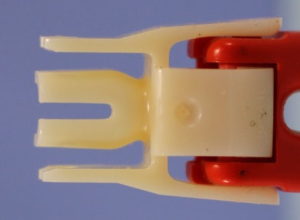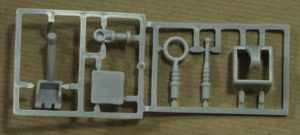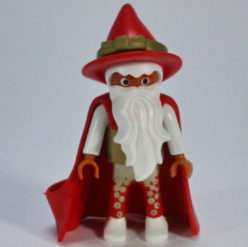Antex see Licensee
Aurimat see Licensee
Color. Several (at least 61) Playmobil sets released between 1978 and 1992 (mainly in the first three years of that timespan) had mainly white parts and were supplied with felt-tipped pens. The owner could colour in the parts according to their own preferences. Special tools to hold a klicky whilst decorating it were included. There is a possibility that a slightly different plastic was used in Color sets, which would ‘take’ the felt pen ink more readily. A few sets not in the Color range also contained unprinted animals and felt pens, e.g. 3189 and 3145.
Custom. A Playmobil klicky, vehicle or other item which has been ‘redesigned’ by a collector to create something new. With klickies, for example, many parts are interchangeable, making customisation of klickies relatively easy (although taking a klicky apart can be a challenge!). I prefer to call customised klickies ‘recombinants’ (biological influence!). There is often no way of being certain that a given klicky is an original or a recombinant/custom, unless it is a combination of parts which never existed in a Playmobil set.
Dietenhofen Site in Germany where Playmobil is manufactured.
DS. Direct Service. The department of Playmobil which supplies spare parts for sets from recent years. DS also reissues ‘vintage’ sets (usually identical to the original set but with a different set number and nearly always without the klickies) and ‘add-on’ sets containing 2 or 3 klickies or extra accessories to allow buyers to expand their Playmobil world. For fuller details of the DS catalogues, see this article. Rebranded ‘Playmobil Plus’ in 2021.
ETN see Part number
Exclusive set A set issued for a restricted market, for example USA/Canada, Greece, Playmobil Funparks, etc. Some exclusive sets are commissioned by a particular company, organisation or town to promote or commemorate their products, services, anniversary, etc. PCC members were given exclusive sets and klickies.
Famobil. See Licensee
geobra. Short for George Brandstätter, a former Director of the company (geobra Brandstätter Stiftung & Co. KG) which makes Playmobil. I use this word when referring to the manufacturing company as opposed to the product.
HTTYD How to Train Your Dragon. Sets based on the DreamWorks Animation films, issued under licence by Playmobil as ‘DreamWorks Dragons’ sets. The films were (loosely) based on Cressida Cowell’s books.
Klicky. A Playmobil human figure. (In some parts of the world, ‘Klicky’ is used for male figures and ‘Klacky’ for females). Some people spell it ‘clicky’ and the plural can be klickies or klickys.
Licensed theme, Licensing partners. Since 2017, geobra has released sets reflecting themes, cars, films or TV programmes where the copyright is owned by others, used under licence. To date, these have included Heidi, Scooby Doo, Back to the Future, Ghostbusters, How to Train Your Dragon, James Bond, Knight Rider, The A Team, Asterix, Spirit Riding Free, Star Trek, VW, Porsche, Mini Cooper and Mercedes Benz.
Licensee. Company (formerly) producing and marketing Playmobil sets under licence and an exclusive brand name (Famobil, Lyra, Schaper, Trol, Antex, Aurimat, Marx Toys and others). For example Marx Toys based in Swansea, UK marketed ‘Playpeople’ sets between 1975 and 1980. Some licensees may have actually manufactured certain parts, others may have just assembled parts made in Germany, then packaged and marketed exclusive sets. Today, Playmobil has subsidiaries in many countries which have replaced the former licensee companies. Some collectors regard licensee-produced sets as equal in status to those created by Playmobil. For me, the quality of Marx Toys klickies (especially the face printing) is often inferior to German klickies of the same vintage. Further details here
Lyra. See Licensee
Malta. One of the locations outside of Germany where Playmobil is manufactured, especially klickies.
Marx Toys. See Licensee
MI[S]B. Mint in [sealed] box. A requirement of many collectors, not just Playmobil collectors, is that an item should be completely unused and still sealed in its original packaging. Personally, I like to handle the toys, so I have very few MISB sets.
Mould/Mold number Many parts have a mould number embossed on them. See bucket pictured below. This is NOT a part number. Nor is the year shown on some parts (example below on the underside of a car) the year of manufacture, but the year the mold was first used.


Mystery figures, Mystery fi?ures Figure sold in a sealed bag. The first two series (12 male figures, 12 female) were issued in 2011. 1 or 2 series have been released every year since. 2022 will see series 21 and 22 issued.
Part Number All parts have an 8-digit part number, usually in the form 30 nn nnnn, (missing out the spaces also works on PlaymoDB and Playmobil websites). The part number or ETN (German: Ersatzteilnummer) is unique to a given shape and colour part. Playmodb is the best place to find part numbers, though some parts have unknown numbers and are given a ‘place-holder’ number such as pnnnn, or knnnn for klickies. For more information see here.
PCC Playmobil Collectors Club. An international club set up by geobra and collectors which flourished between 31 October 2012 and 31 December 2017, before it was shut down by geobra, to the enormous disappointment of collectors.
Playpeople, See Licensee
Schaper. See Licensee
Serie Rosa. (Pink Series) Sets in the Victorian theme issued in pink boxes between 1987 and 1999; see here
Set A group of parts produced and sold by Playmobil as a unit, in a box, bag or blister pack. Most sets have a 4-digit number in the range 3001 to 9999. Sets range from a single part or a single klicky with acccessories up to a large and complex building with several klickies.
Set number 4 or 5 digits long, in the range 3000 to 9999 or 70000 up.
About 300 set numbers have been used more than once, for different sets, which can cause confusion unless an additional letter is added to the set number (PlaymoDB uses x, y, z, a or b. Playmobil.de Produkt-Arkiv uses A and B).
5 digit numbers beginning with a 7 were introduced for sets released in December 2019, 5-digit numbers beginning with an 8 were introduced before this and are used for Playmobil Magazines.
8-digit numbers (actually part numbers) are used for some single-klicky sets.
Skeleton. The internal armature of a klicky, which holds the legs, arms and head in place while allowing them to move. Mystery figures have a skeleton which allows the parts to be more easily disassembled, so the klickies can be customised. The earliest klickies had coloured, black or white skeletons. After the mid-1970s, klickies had off-white (see picture) or grey skeletons.

Sprue The plastic which holds smaller parts together during the injection-molding process. Sometimes parts are supplied on the sprue, sometimes this is removed by the set packer. Parts on one sprue have the same part number.


Steck. A Playmobil building system in which walls, etc. are connected by tabs which fit into slots. Used for earlier buildings such as castles, farm buildings and others. The word may come from the German word for ‘plug’ or ‘slot’.
System X. A building system used after Steck, for many buildings. Parts have sockets with red and yellow (occasionally white, grey or blue) connectors to join parts together.
System Y. This may be a collector’s term. A building system used in more recent sets where walls and other building pieces fit together in specific ways. Often the parts cannot be combined with parts from other sets, seriously limiting the range of customisation possible and leading some Playmobil collectors to call this ‘System why?’
Trol see Licensee
Version. Sets are sometimes reissued with slight differences in the later version. Many of the differences are in the style of packaging, but sometimes the set contents differ radically between versions. For a full review, see here and here.
Zirndorf. The site in Germany where Geobra headquarters is based, near Nürnberg
Page updated 20 May 2022
